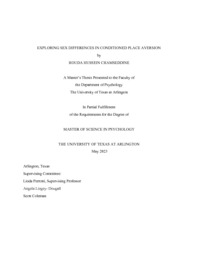
ATTENTION: The works hosted here are being migrated to a new repository that will consolidate resources, improve discoverability, and better show UTA's research impact on the global community. We will update authors as the migration progresses. Please see MavMatrix for more information.
Show simple item record
| dc.contributor.advisor | Perrotti, Linda | |
| dc.creator | Chamseddine, Houda Hussein | |
| dc.date.accessioned | 2023-06-14T17:07:49Z | |
| dc.date.available | 2023-06-14T17:07:49Z | |
| dc.date.created | 2023-05 | |
| dc.date.issued | 2023-05-22 | |
| dc.date.submitted | May 2023 | |
| dc.identifier.uri | http://hdl.handle.net/10106/31287 | |
| dc.description.abstract | Substance use disorder is a chronic condition characterized by cycles of intoxication, withdrawal, and relapse. Negative affective and somatic symptoms commonly accompany cessation of substance use. These symptoms can be incredibly aversive, to the extent that they can be classically conditioned to be associated with cues or environments. Women show greater cue-reactivity to drug-associated stimuli and progress from casual drug use to abuse at a faster rate compared to men. Human and animal literatures strongly suggests that these elevated vulnerabilities in females are associated with changes in levels of circulating ovarian hormones. Studies investigating sex differences and hormonal influences during opioid withdrawal (OW) and their motivational influences are severely lacking, and the few that address sex as a variable report disparate findings. A sizable portion of the existing knowledge on OW has been obtained from research that is limited to men and male subjects and extrapolated to women, including scales assessing withdrawal. Thus, the objective of the present study was to investigate sex differences and hormonal influences in the motivational consequences of opioid withdrawal using a conditioned place aversion paradigm. Specifically, our aim was to ascertain (1) the extent to which gonadally intact, adult male and female rats displayed aversion to environments associated with an acute naloxone precipitated withdrawal after morphine pretreatment during a two- and four-day conditioning cycle, (2) the degree to which elevations in (or elimination of) circulating levels of estradiol influence conditioned place aversion, and (3) the differences in magnitude of conditioned place aversion after varying the dose of morphine and conditioning doses of naloxone in intact females. Overall, our findings suggest the following: (1) Both male and female rats developed significant naloxone-precipitated conditioned place aversion of similar magnitude after two and four days of conditioning. However, this test failed to yield significant sex differences. (2) Estradiol treatment did not appear to affect naloxone-precipitated conditioned place aversion in ovariectomized female rats, as no significant differences were found between estradiol and vehicle (peanut oil)-treated groups. (3) Female rats demonstrated significant conditioned place aversion across various doses of morphine and naloxone. | |
| dc.format.mimetype | application/pdf | |
| dc.language.iso | en_US | |
| dc.subject | Opioid withdrawal | |
| dc.subject | Sex differences | |
| dc.subject | Conditioned place aversion (CPA) | |
| dc.title | EXPLORING SEX DIFFERENCES IN CONDITIONED PLACE AVERSION | |
| dc.type | Thesis | |
| dc.date.updated | 2023-06-14T17:07:49Z | |
| thesis.degree.department | Psychology | |
| thesis.degree.grantor | The University of Texas at Arlington | |
| thesis.degree.level | Masters | |
| thesis.degree.name | Master of Science in Psychology | |
| dc.type.material | text | |
Files in this item
- Name:
- CHAMSEDDINE-THESIS-2023.pdf
- Size:
- 3.082Mb
- Format:
- PDF
This item appears in the following Collection(s)
Show simple item record


